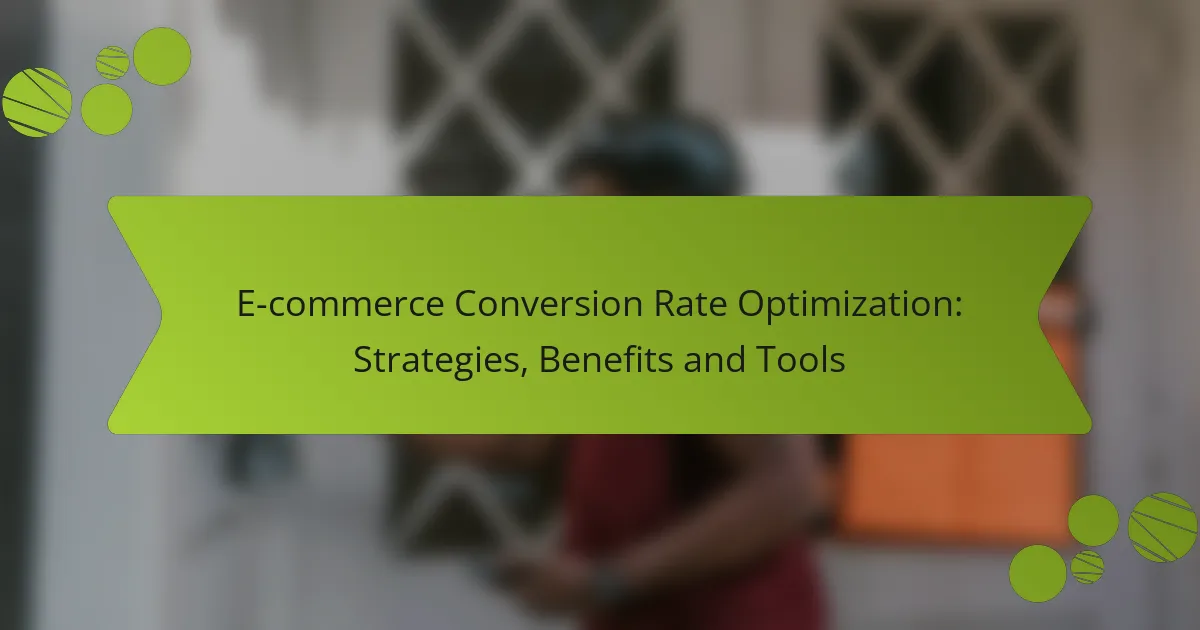E-commerce conversion rate optimization is essential for maximizing sales and profitability by enhancing user experience and encouraging purchases. Effective strategies include personalization, optimizing product pages, and streamlining the checkout process, all of which can lead to increased customer satisfaction and reduced marketing costs. Leveraging specialized tools can provide valuable insights into user behavior, enabling businesses to implement targeted improvements and boost conversion rates.
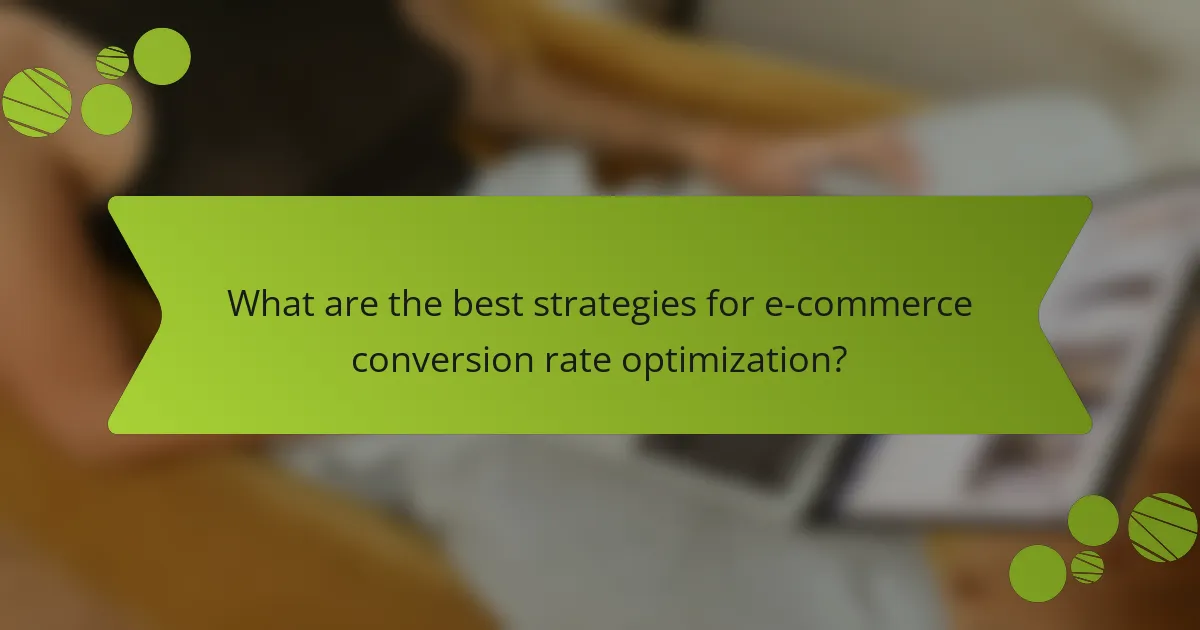
What are the best strategies for e-commerce conversion rate optimization?
The best strategies for e-commerce conversion rate optimization focus on enhancing user experience and driving purchases. Key methods include personalization, optimizing product pages, streamlining checkout processes, utilizing A/B testing, and enhancing mobile experiences.
Personalization techniques
Personalization techniques involve tailoring the shopping experience to individual users based on their behavior, preferences, and demographics. This can include personalized product recommendations, targeted email campaigns, and customized landing pages that resonate with specific customer segments.
Implementing personalization can significantly increase engagement and conversion rates. For example, using data analytics, you can identify popular products among similar customers and showcase them to new visitors, enhancing the likelihood of a purchase.
Optimizing product pages
Optimizing product pages is crucial for converting visitors into buyers. This includes using high-quality images, detailed descriptions, and clear pricing information. Incorporating customer reviews and ratings can also build trust and encourage purchases.
Consider using bullet points to highlight key features and benefits, making it easier for customers to scan the information quickly. A well-structured product page can lead to higher conversion rates, often improving by several percentage points with effective design and content.
Streamlining checkout processes
Streamlining checkout processes reduces friction and encourages customers to complete their purchases. This can involve minimizing the number of steps required to check out, offering guest checkout options, and providing multiple payment methods.
Ensure that the checkout page is user-friendly and mobile-optimized, as many shoppers use their phones for purchases. A complicated checkout can lead to cart abandonment, which is a common issue in e-commerce.
Utilizing A/B testing
Utilizing A/B testing allows you to compare two versions of a webpage to determine which one performs better in terms of conversions. This method helps identify the most effective elements, such as headlines, images, or call-to-action buttons.
Start by testing one element at a time to isolate its impact on conversion rates. Regularly conducting A/B tests can lead to continuous improvement and optimization of your e-commerce site, ultimately boosting sales.
Enhancing mobile experience
Enhancing the mobile experience is essential as a significant portion of online shopping occurs on mobile devices. A responsive design that adapts to various screen sizes ensures that users can navigate easily and make purchases without frustration.
Focus on fast loading times, simplified navigation, and easy-to-click buttons. Implementing mobile-specific features, such as one-click purchasing or mobile wallets, can further improve conversion rates among mobile shoppers.
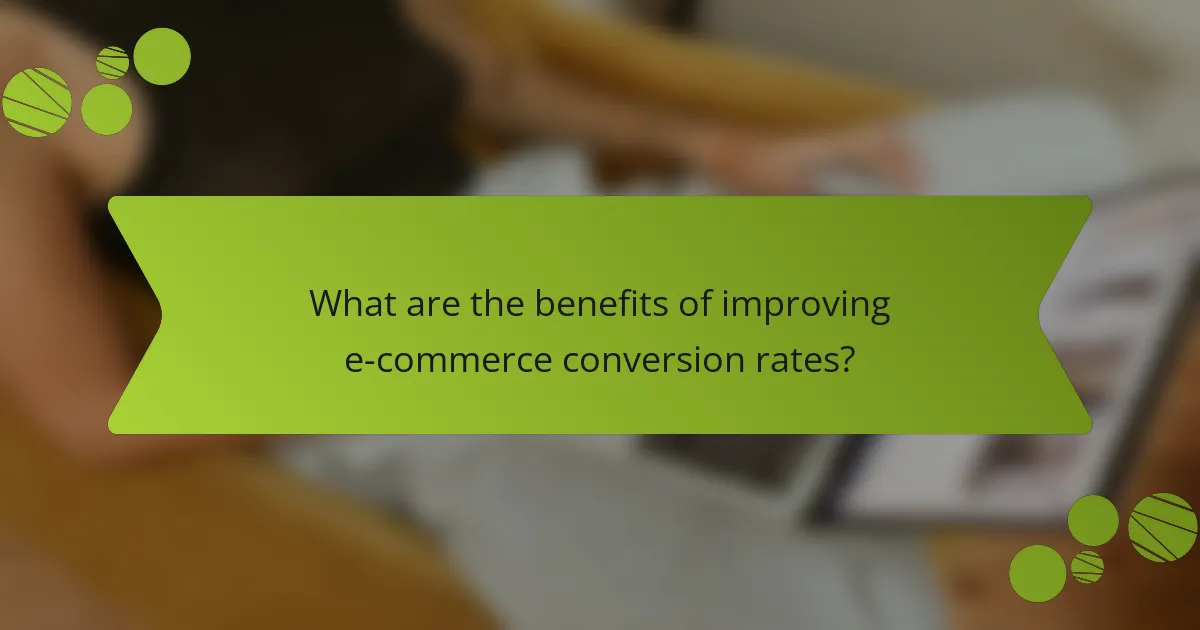
What are the benefits of improving e-commerce conversion rates?
Improving e-commerce conversion rates leads to more customers completing purchases, which directly boosts sales and profitability. Enhanced conversion rates can also reduce marketing costs and improve overall customer experience.
Increased revenue
Higher conversion rates mean that a larger percentage of website visitors are making purchases, which translates to increased revenue. For example, if an online store with 1,000 visitors per month improves its conversion rate from 2% to 4%, it could double its sales without increasing traffic.
To achieve this, focus on optimizing product pages, simplifying the checkout process, and using persuasive calls to action. Small changes, like better product images or clearer descriptions, can significantly impact conversion rates.
Lower customer acquisition costs
When conversion rates rise, the cost to acquire each customer decreases. This is because the same marketing budget can yield more sales, effectively spreading the cost over a larger number of conversions.
For instance, if a business spends $1,000 on ads and previously acquired 50 customers, the cost per acquisition is $20. If conversion rates improve and the same budget brings in 100 customers, the cost drops to $10. This efficiency allows businesses to allocate resources to other growth areas.
Improved customer satisfaction
Enhancing conversion rates often involves creating a smoother shopping experience, which can lead to higher customer satisfaction. Features like easy navigation, fast loading times, and responsive customer support contribute to a positive shopping journey.
Satisfied customers are more likely to return and recommend the store to others, fostering loyalty and generating word-of-mouth referrals. Implementing customer feedback can help identify areas for improvement that directly impact satisfaction levels.
Higher return on investment
Improving conversion rates typically results in a higher return on investment (ROI) for marketing efforts. When more visitors convert into paying customers, the effectiveness of marketing campaigns increases, leading to better financial outcomes.
To maximize ROI, regularly analyze conversion data to identify successful strategies and areas needing adjustment. A/B testing can be a valuable tool in determining which changes yield the best results, ensuring that marketing dollars are spent wisely.
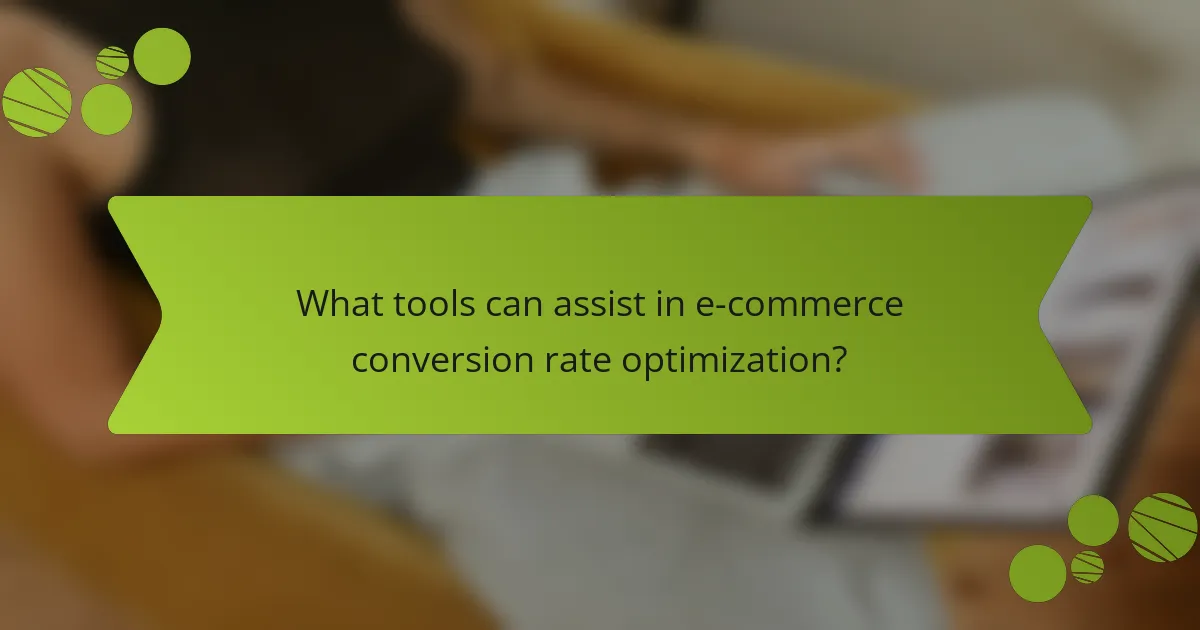
What tools can assist in e-commerce conversion rate optimization?
Several tools can significantly enhance e-commerce conversion rate optimization by providing insights into user behavior, testing variations, and analyzing data. Utilizing these tools can help identify areas for improvement and implement effective strategies to boost sales.
Google Analytics
Google Analytics is a powerful tool that tracks and reports website traffic, offering insights into user behavior and conversion paths. By setting up goals and funnels, e-commerce businesses can monitor how visitors interact with their site and identify drop-off points in the purchasing process.
To maximize its effectiveness, focus on key metrics such as bounce rate, average session duration, and conversion rate. Regularly reviewing these metrics can help you make data-driven decisions to enhance user experience and increase conversions.
Hotjar
Hotjar provides heatmaps, session recordings, and feedback polls to visualize user interactions on your e-commerce site. Heatmaps show where users click, scroll, and move their mouse, helping identify which areas attract attention and which are ignored.
Utilizing session recordings allows you to observe real user behavior, revealing potential usability issues. Combining these insights with user feedback can guide design improvements and optimize the conversion process effectively.
Optimizely
Optimizely is an experimentation platform that enables A/B testing and multivariate testing to determine which variations of your website perform best. By testing different elements, such as headlines, images, and call-to-action buttons, you can identify the most effective combinations for driving conversions.
When using Optimizely, ensure that you have a clear hypothesis and measurable goals for each test. This structured approach helps in making informed decisions based on real user data rather than assumptions.
Crazy Egg
Crazy Egg offers tools like heatmaps, scroll maps, and A/B testing to analyze user behavior on your e-commerce site. Its visual reports help you understand how users navigate your site and where they lose interest, allowing you to make targeted adjustments.
Additionally, Crazy Egg’s A/B testing feature enables you to experiment with different layouts and content. Regularly testing and iterating based on user data can lead to significant improvements in conversion rates over time.
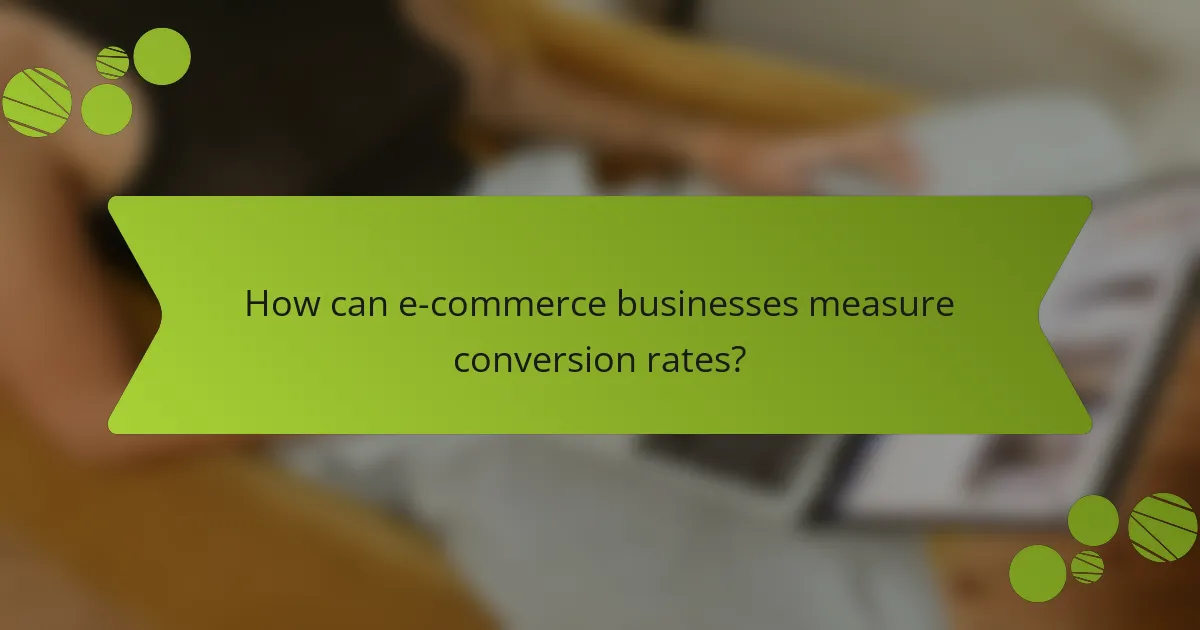
How can e-commerce businesses measure conversion rates?
E-commerce businesses can measure conversion rates by tracking the percentage of visitors who complete a desired action, such as making a purchase. This metric is crucial for evaluating the effectiveness of marketing strategies and website performance.
Defining conversion goals
Defining clear conversion goals is the first step in measuring conversion rates. These goals can include actions like completing a purchase, signing up for a newsletter, or adding items to a shopping cart. It’s essential to specify what constitutes a conversion for your business to accurately assess performance.
For instance, a retail website might set a goal of increasing completed purchases by 15% over the next quarter. By having specific targets, businesses can focus their optimization efforts effectively.
Tracking user behavior
Tracking user behavior involves analyzing how visitors interact with your website. Tools like Google Analytics can provide insights into user journeys, showing where visitors are dropping off in the conversion process. Understanding these behaviors helps identify areas for improvement.
Consider implementing heatmaps or session recordings to visualize user interactions. This data can reveal which sections of your site attract attention and which may need adjustments to enhance user experience.
Analyzing funnel metrics
Analyzing funnel metrics allows businesses to evaluate each stage of the conversion process. This includes measuring the number of visitors at each step, from landing pages to checkout. By examining these metrics, you can pinpoint where potential customers are lost.
For example, if a significant drop-off occurs at the payment stage, it may indicate issues with the payment process or lack of trust signals. Regularly reviewing funnel metrics can help you make informed decisions to optimize the conversion path.
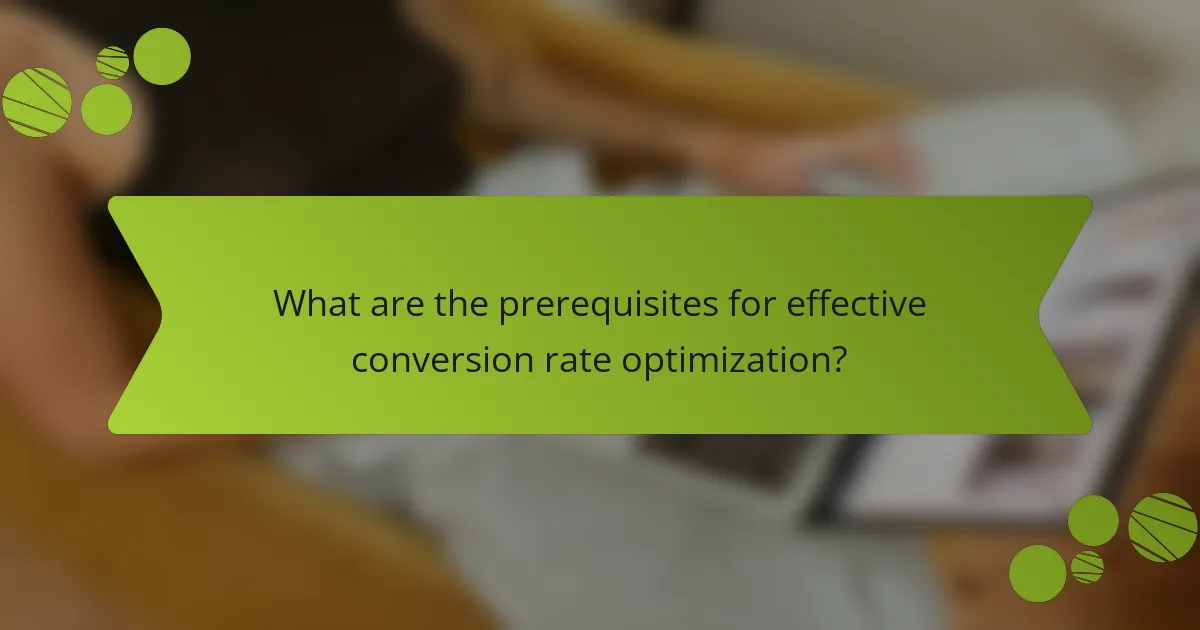
What are the prerequisites for effective conversion rate optimization?
Effective conversion rate optimization (CRO) requires a solid understanding of your audience, clear objectives, and thorough market research. These prerequisites form the foundation for creating strategies that enhance user experience and drive sales.
Understanding target audience
To optimize conversion rates, you must first understand your target audience’s needs, preferences, and behaviors. This involves creating detailed buyer personas that represent your ideal customers based on demographics, interests, and purchasing habits.
Utilize analytics tools to gather data on user interactions with your site. Look for patterns in behavior, such as which products are frequently viewed or abandoned in carts, to tailor your offerings and messaging accordingly.
Setting clear objectives
Clear objectives are essential for guiding your CRO efforts. Define specific, measurable goals such as increasing the conversion rate by a certain percentage or reducing cart abandonment rates within a set timeframe.
Ensure that your objectives align with overall business goals. For instance, if your aim is to boost sales, consider setting targets for specific product categories or customer segments to focus your optimization strategies effectively.
Conducting market research
Market research provides insights into industry trends, competitor strategies, and customer preferences. Use surveys, focus groups, and online tools to gather information that informs your CRO approach.
Analyze competitors to identify successful tactics they employ. This can include examining their website design, promotional offers, and customer engagement strategies. Use this information to enhance your own site and differentiate your offerings.





